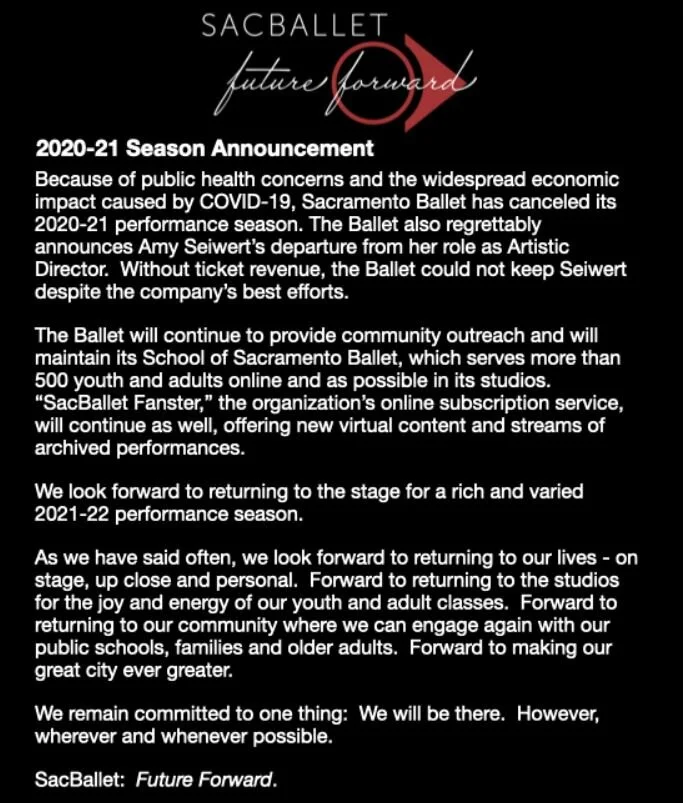Sacramento leads the nation in relief for creative economy
The City of Sacramento has launched one of the most assertive efforts in the country to preserve its creative economy from the economic devastation caused by the Covid-19 pandemic.
Arts and cultural organizations were plunged into immediate crisis in late March as galleries closed, performances and shows were canceled and schools went online. At the urging of Mayor Steinberg, the Sacramento City Council responded by committing to spending $20 million of the $89 million the City received from the federal CARES Act to bolster Sacramento’s arts, cultural and tourism sectors.
That’s twice as much as the next largest allocation from a local government in California — $10 million approved by Los Angeles County.
At Mayor Darrell Steinberg’s urging, City staff and volunteer arts commissioners are evaluating funding applications with a conscious effort to make sure groups and artists from disadvantaged Sacramento communities get an equitable share. Arts mentors have been hired to help them get through the application process.
“My city has stepped up to the plate: I don’t know any other city that has stepped up the way Sacramento has,” said Tamaira “Miss Tee” Sandifer, CEO of Studio T Arts & Entertainment.
Sandifer normally brings hip hop dance and instruction in videography, photography, graphic design and website building out to Sacramento-area schools. But since Covid, she has greatly expanded Studio T’s online offerings and offered them nationwide.
Fairytale Town gate
“A lot of our kids are dealing with things like anger; they’re in pressure cooker situations,” Sandifer said. “It’s not fun for them to be home with stressed out parents. We’ve become a social service program through the arts.
“The arts are a superpower in surviving this for our kids,” Sandifer added.
Anthony Krutzkamp, executive director of the Sacramento Ballet, said he thinks Sacramento’s $20 million commitment to arts and cultural institutions hurt by Covid-19 is the largest distribution in the country. By comparison, he said, Phoenix allocated just $2.1 million for the arts despite receiving a much larger CARES Act check of $293 million. Portland received $114 million in federal stimulus money and allocated $4.35 million for arts and culture.
“We are so thrilled to see the City of Sacramento prioritizing the creative sector with their CARES Act funding allocation from the federal government,” said Julie Baker, executive director of Californians for the Arts. “We applaud Mayor Steinberg’s leadership and recognition that a healthy city needs a vital arts and culture ecosystem. As the arts and creative industries were the first to close and likely the last to reopen to full capacity, the sector has experienced a disproportionate impact from Covid 19, and extraordinary measures are needed to save arts and culture in California.”
Sacramento Ballet announces cancellation of season and departure of its new artistic director due to the economic impact of Covid-19.
On June 30, the City Council approved specific plans for the first $7.5 million of the $20 million earmarked for arts and culture. The allocation includes $1.5 million for cultural institutions located in City-owned facilities and another $1.1 million for existing City grantees. Under the rules for the federal stimulus, the money can only go to reimburse organizations for operating expenses such as rent payments or deposits on performance venues from March 1 and the end of June, said Ray Gargano, arts program coordinator for the City.
Recipients in those two categories have already been notified of their awards and are finalizing their contracts with the City. They include household names like Fairytale Town and the Sacramento Zoo along with smaller organizations such as the the Latino Center of Art and Culture, Women’s Wisdom Art, Studio T and the Sojourner Truth Museum. Gargano said he expects the money to go out as soon as next week.
Marie Acosta, executive and artistic director of the Latino Center of Art and Culture, said the $17,000 CARES Act allocation it will receive from the City is “a godsend.”
“When we closed on March 15 we furloughed staff, cancelled contracts with local publicists and artists and canceled our entire season,” Acosta said. “Our artists come from our community. The Latinx community has been one of the hardest hit by Covid-19.”
Another $4.9 million of the first $7.5 million in grants remains to be awarded for expense reimbursement or new programming designed to address the effects of the pandemic, such as providing arts education online. When the application period for this first round of funding closed, 426 entities had applied for amounts totaling $16 million, far more than what is available. Eligible applicants include artists, creative businesses, arts education programs, and cultural equity organizations.
“About 300 of the applicants were creative businesses and organizations that the City had never worked with before,” Gargano said.
Gargano said it’s likely all of those who qualify will be funded, though not for all they had requested. The City’s Arts Commission will make the final decisions.
Arts leaders say the City funding will help them survive until regular programming can return. In the meantime, they are getting creative about how to employ artists and connect with the community when large gatherings are prohibited and everyone is supposed to stay six feet apart.
The Latino center is planning a drive-through El Panteon de Sacramento/Day of the Dead celebration at its property on Front Street south of downtown. “The place will be filled with altares, memorials to our departed loved ones, the smell of copal (incense), and it will be lit with projected videos of our past celebrations,” Acosta said.
Altars celebrating ancestors are central to Day of the Dead.






